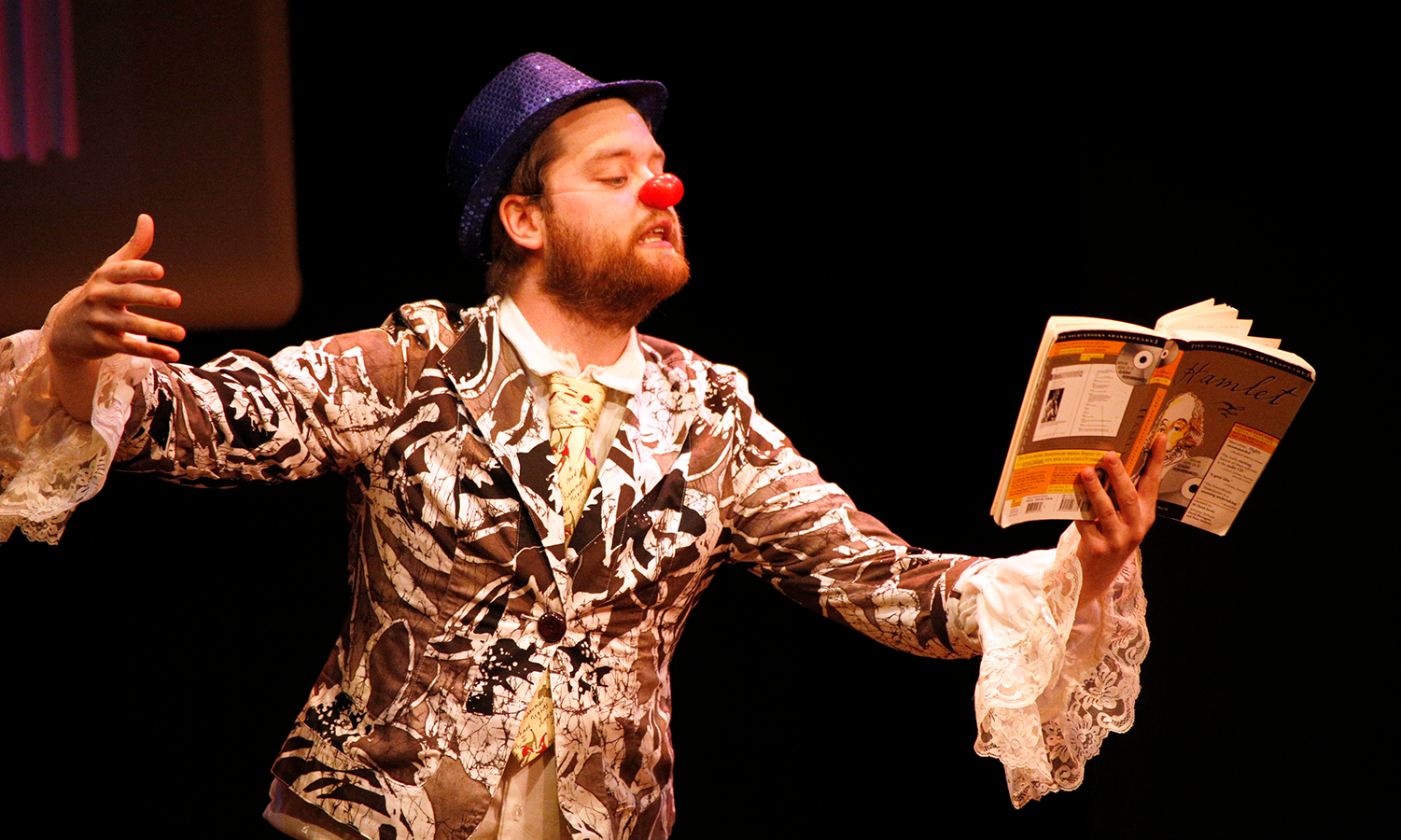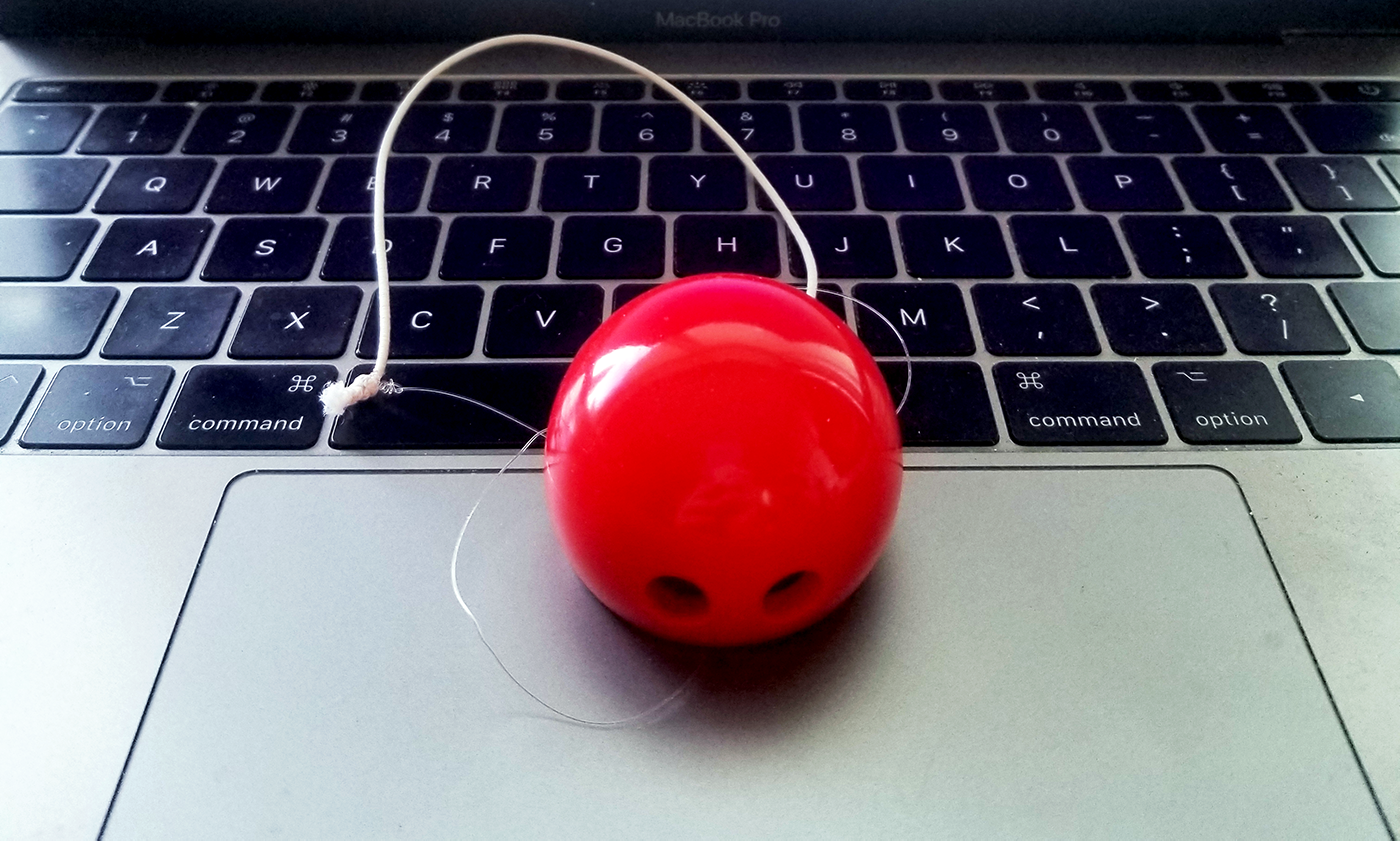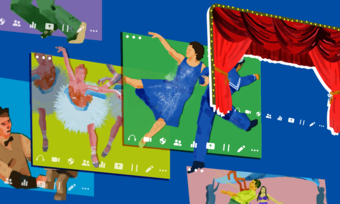Relationship to Audience
To me, good clowns thrive on their relationship with the audience. The Short Cuts tech team informed me there was no way to involve the audience directly using the OBS platform. YouTube allowed comments on the livestream, but the actors would not have access to them in real time. I’ve seen various digital performances use comments to great effect, but in every case they’ve been used to support verbal rather than physical storytelling: comments, after all, are words.
When doing comedy, lack of immediate connection to an audience can be disconcerting. Generally, the reactions of an audience directly affect a comedic performer's rhythm and dynamics in real time. It takes an incredible performer to build a rapport with an audience they have no ability to sense. This is true both in rehearsal and in performance. As a director, in the rehearsal room I try to be generous with my laughter for a variety of reasons: to encourage actors to continue in a certain direction, to get them used to being in front of a reactive audience, and because I truly enjoy being made to laugh! But rehearsing No. 7 via Zoom required me to mute myself while the actors were performing lest my audio overtake theirs. The OBS platform required my video to be off as well. By the end of the run, the performers had spent weeks rehearsing and then performing a bizarre comedy not once having heard anyone laugh.
Because the performer has no direct connection to the audience, the clowning must become more like film comedy and less like the live comedy of theatre. It relies more on a performer’s internal sense of rhythm and humor than on their ability to play off and respond to the audience. Unlike with film, however, there is no editor to adjust the rhythm after the fact. Like theatre, the performers must navigate the performance in real time. Watching and guiding theatre performers and clowns in this new, disconnected medium reminded me of early film comedy like the Marx Brothers, who were often adapting material crafted for or influenced by the Vaudeville stage. This was especially true for No. 7 because we were adapting a script that had been written for the stage. In the case of Oblong and Oboe, we were working on physical material intended to one day be performed live.
Because the performer has no direct connection to the audience, the clowning must become more like film comedy and less like the live comedy of theatre.
Theatricality
No. 7 is a physical comedy that explores themes of mental health. It relies on various moments of audience interaction and a lot of direct address. When I first read the script I got excited; I was teeming with ideas about how to execute the physicality that drove the storytelling and the comedy, and was eager to work with the actors, Johanna Arnott and Miki Wolf, on engaging with—as opposed to talking at—the audience. Our new digital medium made this audience interaction impossible. Nonetheless, I wanted to honor the playwright’s intentions and the meaning made by the play.
The medium of the internet offered many moments of theatrical magic that would not have been possible in a theatre. For example, with the actors in different living rooms in different provinces, the normally unremarkable task of passing objects between them became an opportunity for playful slight-of-hand with objects disappearing off-screen in one frame and reappearing in another. The act of passing a playing card between actors during a magic trick became a joyous moment that contributed to creating a theatrical reality. So too did a moment when Johanna tossed a piece of paper off-screen only to have it hit Miki in the face a moment later, thanks to a well-timed off-screen throw. In talking to audience members and fellow artists, I came to appreciate that these moments invited audiences to relax into the form—not to be tricked into believing the actors were sharing a space, but to willingly suspend their disbelief and allow for meaning (and comedy) to be made in this particular medium.
No. 7 includes a scene in which the main character goes into the audience seeking high fives. With the actor in isolation, how could we achieve that moment? In this case, we turned to an old rather than a new form: puppetry. Thanks to a delightful and slightly scary prop—a severed arm—which could be puppeteered from off camera, Johanna was able to provide both sides of the high five. The prop and the moment quickly became a favorite of hers and provided another moment of theatricality.
Film is so often the domain of the ultra-real. Special effects are celebrated for how little they look like effects. Scenes are usually staged with the goal of minimizing the audience’s awareness that they are staged. What we were doing was not film. If anything, it was more like live TV. But truly it was closest to theatre. We maintained the theatricality by relying predominantly on techniques that embraced a playful but coherent stylization.
What we were doing was not film. If anything, it was more like live TV. But truly it was closest to theatre.
The Camera
In online theatre, the camera becomes a stand-in for the audience. During our Oblong and Oboe clown explorations, Jalisa found some excellent moments of humor as the clown worked to frame the shot just how they wanted it—and reacted spontaneously and honestly to the failures to do so. To me, this was the very best way we found to maintain the spontaneity of live clowning. While doing her own clown improvisations along with us, Alyssa also used proximity to the camera to great effect—especially because the limitations of the internet at her rural home meant that her video quality was not always high. The camera also allows for “offstage” humor, such as Jalisa’s use of a classic gag: exiting and allowing audience members to hear a series of crashes, bangs, and vocalizations, leaving them to imagine rather than see the chaos.
Because everything takes place within a rectangular frame, the physical space of the performer becomes the stage. In some ways the frame mirrors a proscenium, and the No. 7 team was able to conceive of the actors’ position within it in similar ways to how one might think of upstage and downstage. We also had to think, however, in cinematic terms, trying to frame actors in appealing ways. It looked odd to have too much headroom, for example, or for half of an actor’s face to be out of frame. Unlike with Oblong and Oboe, the theatrical reality we established for No. 7 did not involve moving the camera, so creative work in physical space was required: Johanna, for example, had to do a strange squat/straddle of her piano bench so that she would have appropriate headroom while sitting close to the camera but also appropriate headroom while standing farther back (or “upstage”).
The freedom to move back and forth allows actors to create distance or increase intimacy and to perform with more of their bodies than if they were limited to a shoulders-up framing. Jalisa’s clown Oboe played delightfully with scale, setting up a tiny restaurant of doll-sized props close to the camera and then lurking, ridiculously large, farther behind it. While clowns often play with scale onstage (think oversized shoes and props or too-tight clothing), an audience in a theatre cannot get as close as a camera can, and thus new possibilities for the minute are created. In No. 7 Johanna created a great comedic moment using proximity to the camera: while performing a card trick (poorly), the audience could see that she was keeping one card separate between her fingers—playing it off as unintentional, of course. This was only possible because of her ability to create an extreme close-up of her hands. Likewise, at the top of the play when Miki winds up to punch Johanna, both were framed in extreme close-up, creating a moment of comedic intensity that would not play in the same way onstage.
For No. 7, we decided that both actors would face the camera rather than look left or right, off-screen, to talk to each other. We felt that the audience would readily accept that in this theatrical reality, looking at the camera meant looking at the other person, just like in everyday uses of webcams. This allowed the audience to see the performers’ faces and eyes clearly. Importantly, it also allowed the actors to see each other on their screens and therefore to be more aware of what the other was doing. As in the theatre, I firmly believe that in livestreamed performances the connection between the performers is of paramount importance. The direct address elements of No. 7 became, by necessity, moments of “talking at” but the moments between the characters had Miki and Johanna looking each other in the eye, responding to what was actually happening between them, even if it was mediated by cameras and screens.
If we are to continue making live performance online, we must work to understand the tools and aesthetics of the new form just as we have worked to understand live, in-person performance.
Design
One element that was neglected in many of the livestream theatre pieces I saw in the early days of the pandemic was design. For No. 7, however, design played a major role in creating the reality of the play and establishing the comedic tone through music and visuals. Many pieces in Short Cuts used the actors’ actual homes to great effect and some experimented with chroma keying (green screening) actors into digital environments. For No. 7, we opted, instead, to create a theatrical environment not based in reality. Thus, the actors found spaces in their homes that were as blank as possible, like a single-tone wall behind them.
Among other things, the simplicity of the physical space allowed the costumes (drawn, by necessity, from the actors’ own wardrobes) to pop and become more prominent elements. A very astute offer suggested by Miki late in the process resulted in one of my favorite design elements. Due to the lighting situations in their homes and the workings of their respective webcams, Johanna’s video seemed to have warmer tones while Miki’s had cooler tones. Miki suggested she wear a warm-toned shirt to contrast Johanna’s cool-toned one. This gave the whole thing a slightly Wes Anderson feel. I am especially fond of this because it represented an embrace of things as we encountered them—a central tenet of clown—rather than trying to change the reality digitally (externally) with color correction.
In our clown work, costumes also play a huge role. They tend to eschew the realistic at the best of times, but something about the bold, over-the-top costumes and props of the clown reads differently on livestream. Perhaps this is because we are used to “normal” or everyday settings being shown on Zoom and therefore the ridiculous, whimsical, and fantastical seem to pop. In our case, they were also set against unstylized backgrounds, so the juxtaposition helped make them stand out.
The digital design of No. 7 embraced theatricality by applying layers of video and images around the frames in which the actors were performing. OBS allowed designer Brooklynn Bitner to manipulate those frames in various ways. In performance, stage manager Judith Shulz and technician Micah Elgaard executed cues in which the frames moved around the screen, changed in size, and/or moved backward and forward among layers. Characters could exit by having the video feed leave the screen, and they could also move backward and forward, up and down in digital space via the frames’ positions relative to one another—in addition to their positions in physical space relative to the camera. Thus, one character could become smaller and farther back, allowing the other to “take the stage.”
Scenes could also be changed by applying different backgrounds. These could be static (such as an image of crumpled paper) or moving (such as when a video of a boxer in a ring played behind the performers while Rocky-style pump-up music blasted). When one character encouraged the other to perform the magic trick she had been rehearsing, a cartoon theatre appeared around her video feed and campy circus music provided by our sound designer tBone began to play.
We also experimented with visible text. In OBS, we were able to have words appear, erase themselves, scroll, and more. This could be done beneath, around, or overtop of actors’ video feeds. Another notable effect was Miki’s video freezing mid-punch, allowing Johanna to embark on a monologue, ostensibly while the punch was in-progress.












Comments
The article is just the start of the conversation—we want to know what you think about this subject, too! HowlRound is a space for knowledge-sharing, and we welcome spirited, thoughtful, and on-topic dialogue. Find our full comments policy here
Charlie Peters
Thank you for this thorough essay on the subject. I have been doing online clowning with my medical clown team for several months. You brought up some of the methods we’ve been using online and introduced some new ideas that we can explore.
I'm so glad this rang true to your experiences and maybe offered some new possibilities Meredith! Medical clowning is something I have no background in but have always been fascinated by and held in such high regard. I bet so much has changed for you folks since the pandemic.